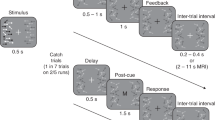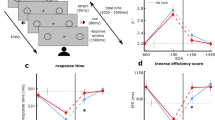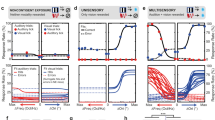Abstract
Restrictions to attentional capacity are revealed by the interference that commonly results when two sensory inputs must be identified at the same time1. To investigate this phenomenon within and between modalities, we presented streams of visual and/or auditory inputs, containing occasional targets to be identified and recalled. For two visual or two auditory streams, identification of one target produced a sustained reduction in the ability to identify a second, the period of interference lasting for several hundred milliseconds. Subjectively, when attention was assigned to one target it was temporarily unavailable for another. In contrast, there was no such time-locked interference between targets in different modalities. The results suggest a modality-specific restriction to concurrent attention and awareness; visual attention to one simple target does not restrict concurrent auditory attention to another.
This is a preview of subscription content, access via your institution
Access options
Subscribe to this journal
Receive 51 print issues and online access
$199.00 per year
only $3.90 per issue
Buy this article
- Purchase on Springer Link
- Instant access to full article PDF
Prices may be subject to local taxes which are calculated during checkout





Similar content being viewed by others
References
Broadbent, D. E. Perception and Communication(Pergamon, London, (1958).
Posner, M. I. & Petersen, S. E. The attention system of the human brain. Annu. Rev. Neurosci. 13, 25 –42 (1990).
Treisman, A. M. & Davies, A. in Attention and Performance IV(ed. Kornblum, S.) 101 –117 (Academic, London, (1973)).
Pashler, H. Dual-task interference in simple tasks: data and theory. Psychol. Bull. 116, 220 –244 (1994).
Duncan, J., Ward, R. & Shapiro, K. Direct measurement of attentional dwell time in human vision. Nature 369, 313 –315 (1994).
Broadbent, D. E. & Broadbent, M. H. P. From detection to identification: response to multiple targets in rapid serial visual presentation. Percept. Psychophys. 42, 105 –113 (1987).
Raymond, J. E., Shapiro, K. L. & Arnell, K. M. Temporary suppression of visual processing in an RSVP task: an attentional blink? J. Exp. Psychol: Hum. Percept. Perf. 18, 849 –860 (1992).
Logan, G. D. Attention in character-classification tasks: evidence for the automaticity of component stages. J. Exp. Psychol: Gen. 107, 32 –63 (1978).
Bourke, P. A., Duncan, J. & Nimmo-Smith, I. Ageneral factor involved in dual task performance decrement. Q. J. Exp. Psychol. 49A, 525 –545 (1996).
Lindsay, P. H., Taylor, M. M. & Forbes, S. M. Attention and multi-dimensional discrimination. Percept. Psychophys. 4, 113 –117 (1968).
Massaro, D. W. & Warner, D. S. Dividing attention between auditory and visual perception. Percept. Psychophys. 21, 569 –574 (1977).
Driver, J. Enhancement of selective listening by illusory mislocation of speech sounds due to lip-reading. Nature 381, 66 –68 (1996).
Cohen, J. D., MacWhinney, B., Flatt, M. & Provost, J. PsyScope: a new graphic interactive environment for designing psychology experiments. Behav. Res. Meth. Inst. Comp. 25, 257 –271 (1993).
Acknowledgements
We are grateful to Christopher Robinson and Sally Cox for initial work on this project, and to Sophie Scott and Christian Lorenzi for assistance with stimulus generation and measurement.
Author information
Authors and Affiliations
Corresponding author
Rights and permissions
About this article
Cite this article
Duncan, J., Martens, S. & Ward, R. Restricted attentional capacity within but not between sensory modalities. Nature 387, 808–810 (1997). https://doi.org/10.1038/42947
Received:
Accepted:
Issue Date:
DOI: https://doi.org/10.1038/42947
This article is cited by
-
Stress and Novelty: Two interventions to modulate emotional memory in adolescents
Journal of Cognitive Enhancement (2023)
-
Stable isotopes and foraging behaviors support the role of antipredator benefits in driving the association between two marine fishes
Oecologia (2023)
-
Impact of music-based intervention on verbal memory: an experimental behavioral study with older adults
Cognitive Processing (2021)
-
Cross-modal perceptual load: the impact of modality and individual differences
Experimental Brain Research (2016)
-
The importance of sensory integration processes for action cascading
Scientific Reports (2015)
Comments
By submitting a comment you agree to abide by our Terms and Community Guidelines. If you find something abusive or that does not comply with our terms or guidelines please flag it as inappropriate.



